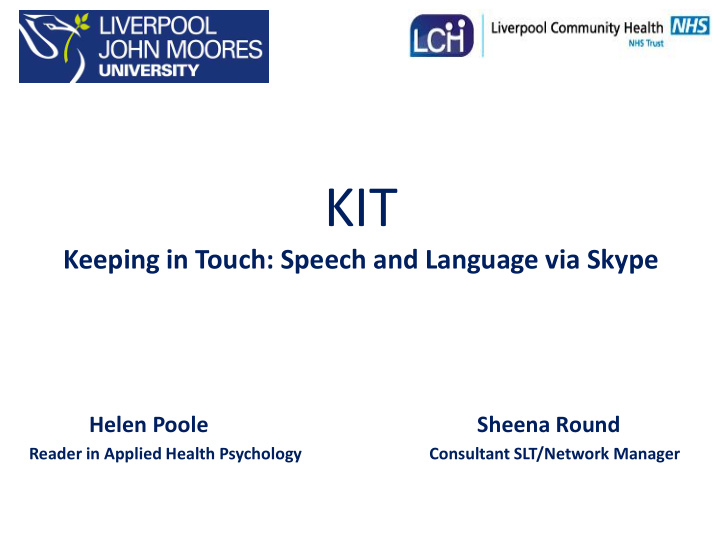



KIT Keeping in Touch: Speech and Language via Skype Helen Poole Sheena Round Reader in Applied Health Psychology Consultant SLT/Network Manager
Outline • Background to KIT Project • Evaluation • Implications • Recommendations
Evaluation: what’s already known? • ‘Remote’ delivery of health care increasing • Clinical use of Skype reviewed (Armfield et al 2013) • In Speech and Language Therapy (SLT) – Videoconferencing review (Theodolos & Hill 2002) – Range of disorders, e.g. stuttering, dysphagia, Parkinson’s disease – Variety of purposes, including: screening, assessment, and review. Limited for therapy – Predominantly adult populations and case series
Evaluation: Rationale & Aims • Data on use in UK NHS context sparse Aims • To evaluate use of Skype to deliver SLT to children within an NHS context • To determine acceptability and engagement • To evaluate any resource implications
Evaluation: Methods • Prospective study using mixed methods • Purposive sample – 7 Speech and Language Therapists (SLTs) – 9 Clients: Children aged between 3 ½ years and 14 years and their parents/carers • SLTs and clients provided with Tablets to Skype • Variety of session types • SLTs and clients completed – On device questionnaire (N=49 sessions) – Interviews at end of study period (N=11)
Evaluation: Findings Table: Percentage agreement with statements Sessions and Resources Online questionnaire SLT Client • Duration (N=49) between Easy to connect 84% 93% 15 & 45 minutes, No difficulty with 80% 93% Mean=27.8 (SD9.9) visual display • Mileage saving per No difficulty with 80% 93% sound session, mean=8.2 Successful interaction 87% 93% (SD10.1), range 0-50 miles • Travel time savings per Projected Savings session M= 26.6 (SD13.2), Travel ~ £87, 000 range 15-60 minutes DNAs ~ £27.000
Evaluation: Clients views Like ‘C’ says, “I think the technology She showed us it…is just easier ‘cos of it is brilliant. It’s such an initially. But after she doesn’t have to advancement. To be able to that you didn’t really miss any of her lunch just use a screen and a need any help setting call…I mean it’s really hour. Or she doesn’t come along...” Acceptability it up. Did you? You have to miss an art knew what you were lesson… doing Convenience and Satisfaction + When you’re on the I think short + Skype you sort of …it is very much I’d say it was all good. sharp bursts…are better. Experience have everything like, having her [child] I wouldn’t say there was And she enjoyed it. And - ready. You’re a little sit on the rug. And doing any negatives to it... she could stay focussed. bit more organised I everything…As you’re Because it was only about think having a therapy session twenty minutes in your living room.
In their own words video
Evaluation summary Findings • Positive response to use of Skype • Connectivity, need for planning • Increased engagement • Resource efficient Limitations • Sample, potential bias
Increased Skype is RIF study Productivity Free Cost provides an Savings evidence From Time base & Travel Patient Equality of Access Centred Links with Low Risk remote mobile Provider working Benefits Quality NHS Service protocol Provided for Skype
Challenges • Confidentiality of data – Agreement to implementation for clients – Risk assessment in NHS – Different way of working for SLTs • New processes needed for loan tablets • Activity data changes • Estate considerations
Future • Trust Support – Trust wide survey based on results of evaluation (staff and service users) • Implementation across SLT – All therapists a possibility • Apps – Procurement process, development
The KIT team Sheena Round, Helen Poole, Ricky Wallace, Paul Fergus, Carolyn Lees, Ursula McCormick, Catharine Barley, Pam Monti, Louise Simcock, Claire Bimson, Lois Hatfield, Catherine Webb, Claire Hanlon, Chelsea Dobbins, Chris Wright, Caroline Rand Acknowledgements: The participants, LJMU, Liverpool Community Health Trust, NHS NW Innovations Fund
References Armfield, N.R., et al. (2012) Clinical use of Skype: a review of the evidence base. Journal of Telemedicine and Telecare, 18(3): 125-7. Beijer, L., et al. (2010). Evaluating the feasibility and the potential efficacy of e-learning-based speech therapy (EST) as a web application for speech training in dysarthric patients with Parkinson's disease: a case study. Telemedicine Journal and e-health, 16(6): 732-738. Carey, B., et al. (2010). Randomized controlled non-inferiority trial of a telehealth treatment for chronic stuttering: the Camperdown Program. International Journal of Language & Communication Disorders/ Royal College of Speech & Language Therapists, 45(1): 108-120. Grogan-Johnson, S., et al. (2010). A pilot study comparing the effectiveness of speech language therapy provided by telemedicine with conventional on-site therapy. Journal of Telemedicine and Telecare, 16(3): 134-139. Hill, A. and D. Theodoros (2002). Research into telehealth applications in speech-language pathology. Journal of Telemedicine and Telecare, 8(4): 187-196. Hill, A., et al. (2009) Using telerehabilitation to assess apraxia speech in adults. International Journal of Language Communication Disorders, 44(5): 731-47. Mashima, P., et al. (1999). Telehealth applications in speech-language pathology. Journal of Healthcare Information Management, 13(4): 71-78. Sharma, S., et al. (2012). Assessing dysphagia via telerehabilitation: Patient perceptions and satisfaction. International Journal of Speech-language Pathology, 15(2):176-83 Sicotte, C., et al. (2003). Feasibility and outcome evaluation of a telemedicine application in speech-language pathology. Journal of Telemedicine and Telecare, 9(5): 253-258. Styles, V. (2008). Service users' acceptability of videoconferencing as a form of service delivery. Journal of Telemedicine and Telecare 14(8): 415-420. Theodoros, D. (2012). A new era in speech-language pathology practice: innovation and diversification. International journal of speech-language pathology 14(3): 189-199. Van den Berg, N., et al. (2012) Telemedicine and telecare for older patients: a systematic review, Maturitas, 73(2): 94-114 (Williams, P. (2012). Speech and language therapists say ‘yes’ to bridging barriers with technology . Telerehabilitation, accessed 12/12/12 http://www.ithealthboard.health.nz/sites/all/files/Telerehabilitation%20Flyer%20v2.pdf
Recommend
More recommend